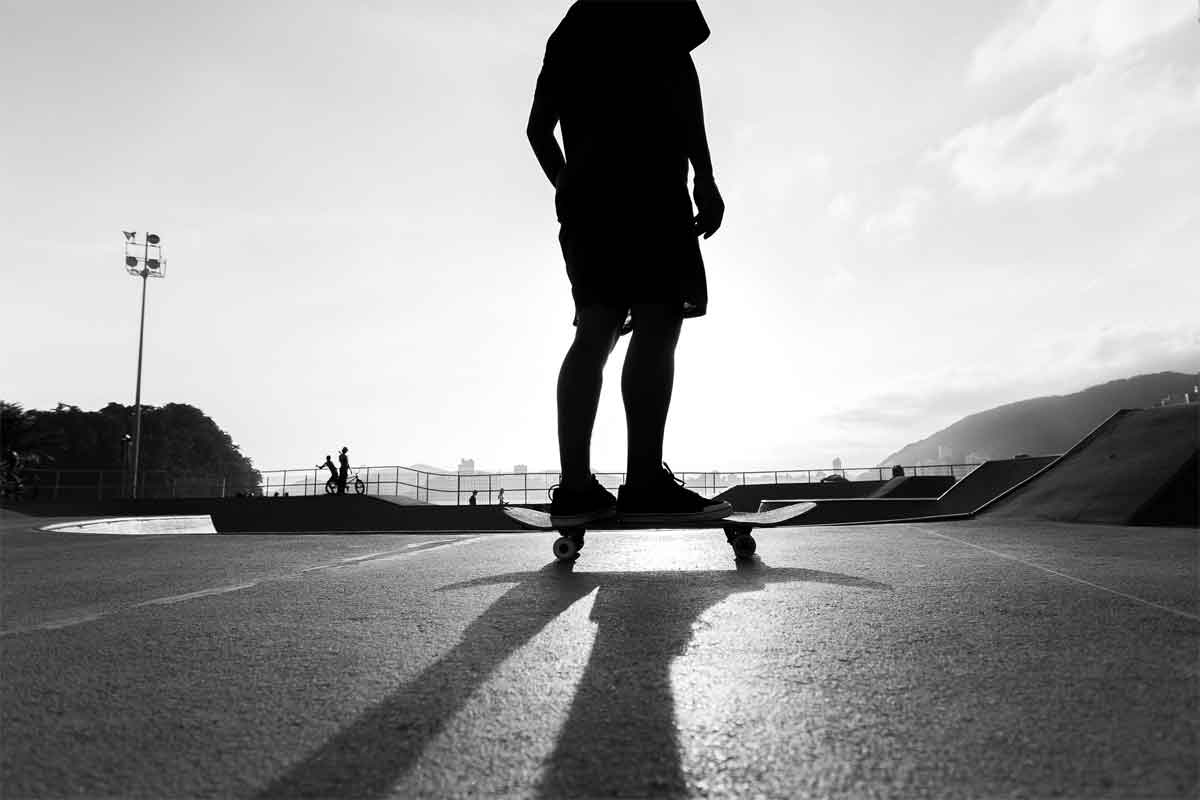In this article, we will cover beginner skateboarding tips, including the necessary skateboard equipment and protective gear, basic skateboarding techniques, skatepark etiquette tips, and some beginner and advanced skateboard tricks.
We’ll also provide tips for setting goals and making the learning process enjoyable, so you can get the most out of your skateboarding experience.
Whether you’re looking to improve your skills, learn new tricks, or simply have fun, these beginner skateboarding tips will help you get started on the right path.
Beginner Skateboarding Tips – Table of Contents
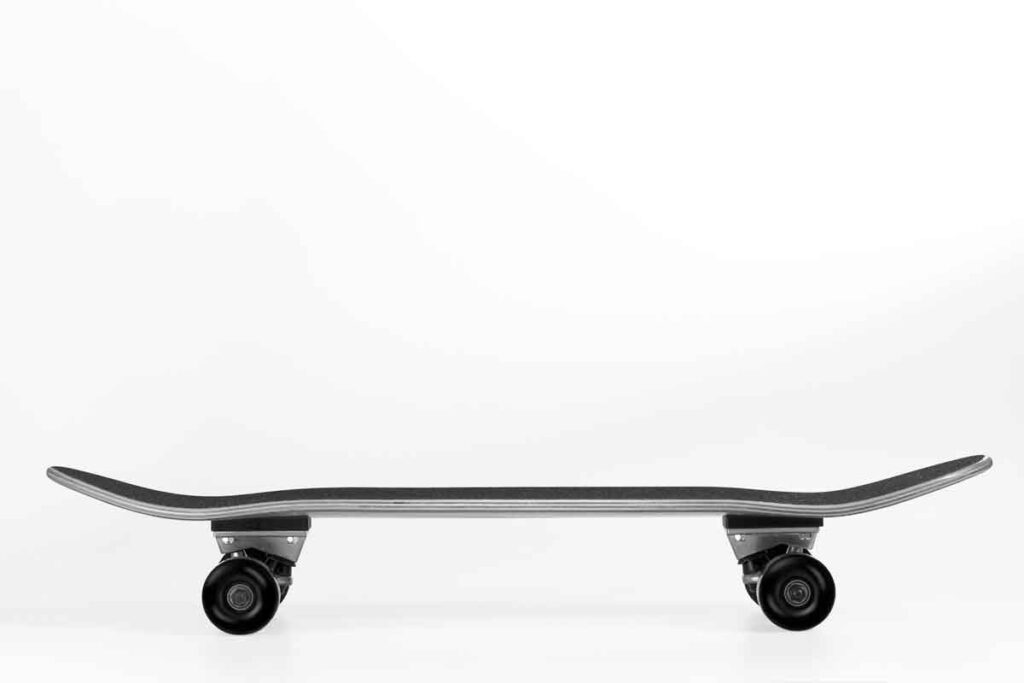
Skateboard Equipment for Beginners
If you are a beginner or just getting back into skateboarding, the most important piece of equipment is a complete skateboard.
Please keep in mind, that when referring to a skateboard, we are speaking about a skateboard deck type (see diagram below).
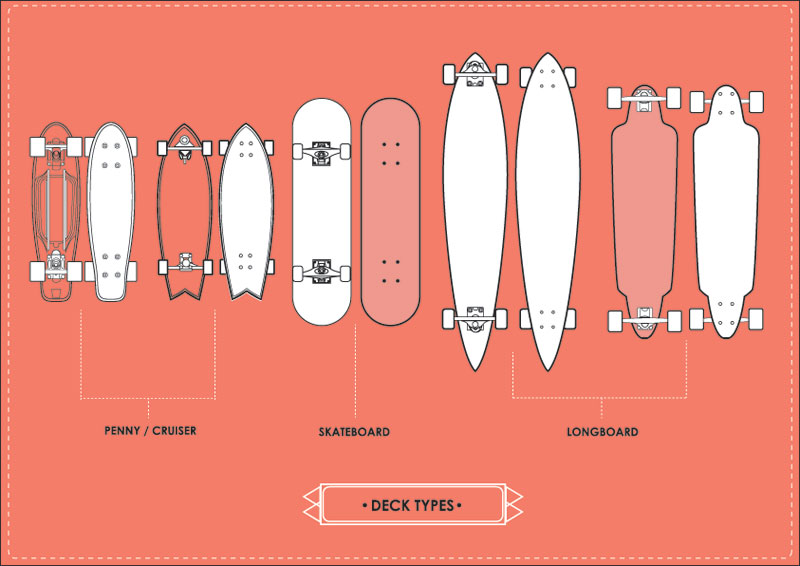
A complete skateboard is a setup that includes a standard skateboard deck, grip tape, two trucks, truck hardware, four wheels, and wheel bearings.
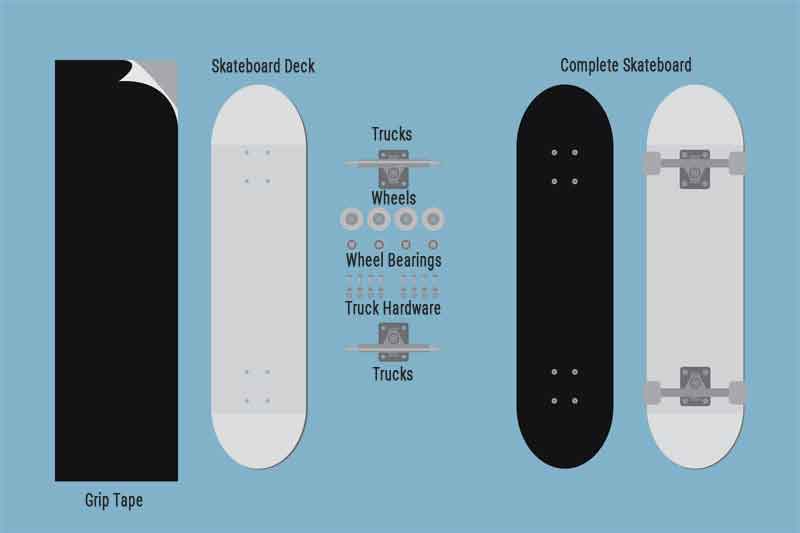
What are the three most important factors to consider when choosing a beginner complete skateboard?
1. Skateboard Deck Size
- The Skateboard deck is the board platform that you place your feet and stand on while riding.
- Beginner Skateboard Deck Size: The wider (7.75 – 8.5 inches wide) the skateboard deck, the better for beginner or returning skateboarders. Wider skateboard decks offer better control and maneuverability.
2. Skateboard Truck Width & Height
- Skateboard trucks are mounted to the bottom of the skateboard deck and allow the skateboard to maneuver, steer, and pivot.
- Beginner Skateboard Truck Width: The most suitable beginner truck size will depend on the width of your skateboard deck. Ideally, you want to have a pair of skateboard trucks installed that align with the edge of your deck. Too narrow of a skateboard truck can cause instability, while too wide of a truck can cause wheel friction and other potential issues.
- Beginner Skateboard Truck Height: Other than truck width size, skateboard trucks also come in two height sizes which include low and high. Low Trucks are considered to be more stable than high trucks do to the low ground profile. High Trucks are better for turning and also offer a larger range of wheel size options. For beginners, we suggest a high truck being that a larger wheel can be used which in return will provide a smoother and more comfortable ride.
3. Skateboard Wheel Size
- Skateboard wheel size will determine how your skateboard rides, feels, and performs.
- Beginner Skateboard Wheel Size: The standard skateboard wheel size ranges from 49 – 75 mm. Generally, the larger the diameter of the wheel the better stability, ease to maintain speed, and smoother ride will be provided. For a beginner, a larger skateboard wheel diameter such as in the 54-60 mm range might be the best fit for the most comfortable and stable ride.
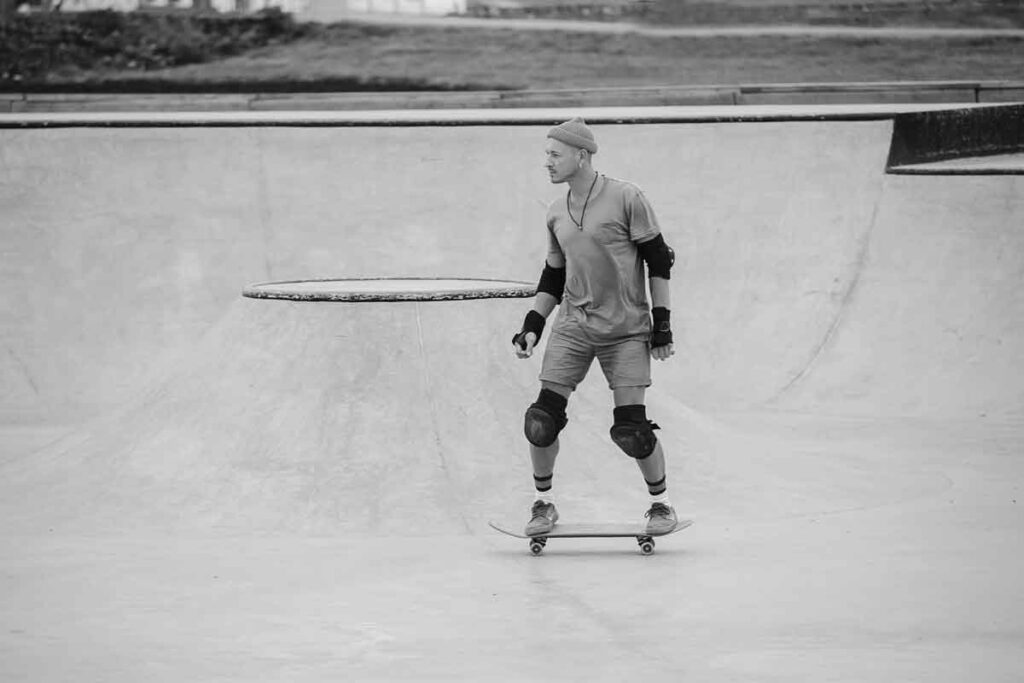
Skateboard Protective Gear for Beginners
As a beginner skateboarder, it’s very important to protect yourself from any unexpected skateboard related injuries. The best way to do so is by wearing the proper skateboard protective gear.
Skateboard protective gear is designed to be worn on the most common impact areas of the body and protects you, the rider, from major injuries.
Skateboard Protective Gear – Recommended List:
| Type | Description |
|---|---|
| Helmet | The skateboard helmet is the most important protective gear that a beginner skateboarder should consider wearing while skateboarding. Well designed skateboard helmets can provide maximum protection while minimizing the risk of injury to the head. |
| Wrist Guards | Other than head injuries, another common injury for skateboarders are wrist fractures. To minimize the risk of injury to the wrist, it’s best to wear a pair of skateboard wrist guards, which are designed to support the wrists from most impacts. |
| Elbow Pads | Skateboard elbow pads are designed to protect your elbows from scrapes and rashes. |
| Knee Pads | Skateboard knee pads are designed to protect your knee caps from sudden hard impacts and reduce the severity of scrapes, cut, rashes, and bruises to the knee and surrounding leg area. |
| Impact Shorts | Impact shorts are designed to protect your buttocks, hips, and thighs from severe injury. The most common type of skateboard impact shorts have thick padding located on the tail bone, hips, and thigh area. |
Skateboard Protective Gear – How to Choose the Right Size and Fit:
| Type | Description |
|---|---|
| Helmet | When selecting a skateboard helmet, it’s important to make sure that the helmet is secure and fits snug around your head. If ordering a helmet online, measure the circumference of your head and refer to the size chart provided by the brand manufacturer. |
| Wrist Guards | When choosing the proper size and fit of skateboard wrist guards, there are three measuring methods that can be used. You can measure the circumference of your palm, length of your hand, or circumference of your wrist. Use the above as guideline as a reference when referring to the brand manufacturer sizing chart. |
| Elbow Pads | To choose the right size and fit of skateboard elbow pads, start by measuring the circumference of your elbow at the widest point. Next, try on the elbow pads and verify that they stay in place while moving your arm around. Adjust the straps for a more secure fit. Lastly, make sure that the elbow pads have good coverage and protection around the elbow area of the arm. |
| Knee Pads | To choose the right size and fit of skateboard knee pads, start by measuring the circumference of your knee at the widest point. Next, try on the knee pads and verify that they stay in place while moving your leg around. Adjust the straps for a more secure fit. Lastly, make sure that the knee pads have good coverage and protection around the knee area of the leg. |
| Impact Shorts | When choosing the proper size and fit of skateboard impact shorts, start by selecting shorts that have an adjustable waistband and a snug fit without being too tight or restrictive. Also, make sure that the impact shorts have adequate padding in the areas such as the hips, tailbone, and thighs. |
Skateboard Protective Gear for Adults
Learn More >>
Start Skateboarding the Right Way: Basic Techniques for Beginners
As a beginner skateboarder, a good starting point is to learn the fundamental basic techniques of skateboarding which are pushing, turning, stopping, and balance.
How to Push on a Skateboard?
To push on a skateboard, first place one foot on the skateboard near the front truck bolts, and place the other foot on the ground, next to the side of the board. Next, slightly lean forward and use your back foot to push off the ground and start moving forward. As you gain momentum, place your back foot on the tail of the skateboard. Repeat this process to maintain your speed.
The following YouTube video from VLSkate does a great job explaining the process of pushing on a skateboard:
How to Turn on a Skateboard?
To turn on a skateboard, you have to shift your weight either onto the front or back skateboard truck. Shifting your weight will cause the skateboard to turn in the opposite direction. To turn left on your skateboard, shift your weight onto the back truck, and to turn right, shift your weight onto the front truck.
To learn how to turn easily on a skateboard, watch the following instructional YouTube video from GOSKATE:
How to Stop on a Skateboard for Beginners?
Foot braking is the simplest and most common method for beginners to stop on a skateboard. This method involves dragging your back foot on the ground to slow down and stop. To perform foot braking, shift your weight towards the back of the skateboard while keeping your knees bent. Next, drag the heel of your back foot on the ground while keeping your toes pointing up. This will create friction and slow you down.
Make sure to watch the following video from Skateboard Park Lessons to learn other methods on How to Stop on a Skateboard:
How to Practice and Improve your Balance on a Skateboard?
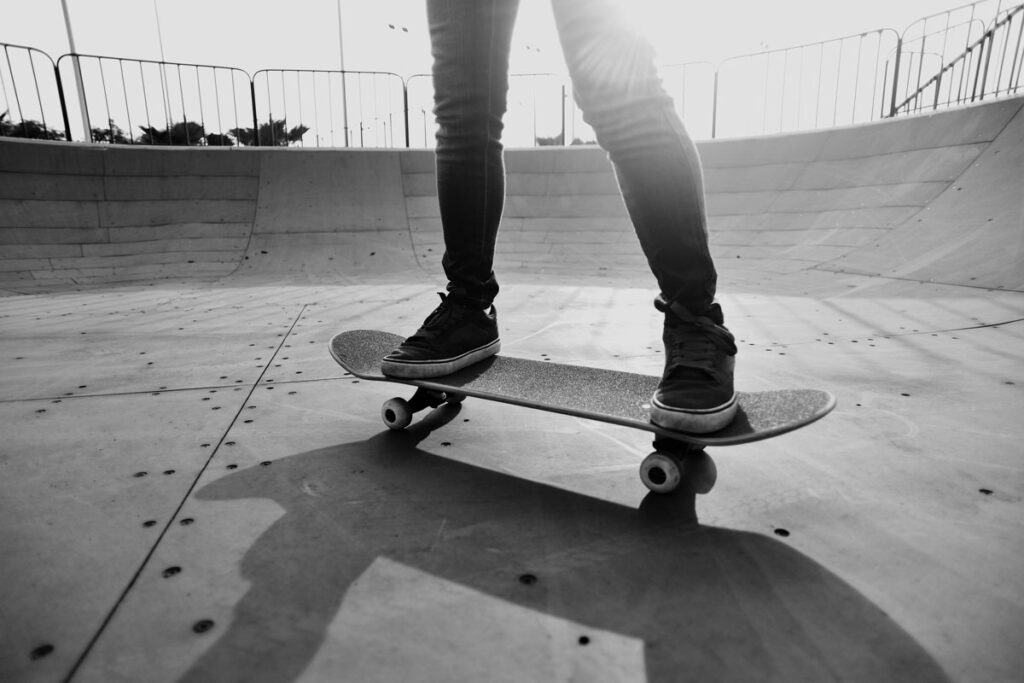
The best way to improve your balance on a skateboard is with regular and consistent practice such as mastering balancing on your board while riding, pushing, and turning.
The following are a few tips to help you improve your balance on a skateboard:
1. Begin with the Basics: Learn how to stand on a skateboard by finding your comfortable skateboard stance and practice staying balanced on the board when you push off and ride.
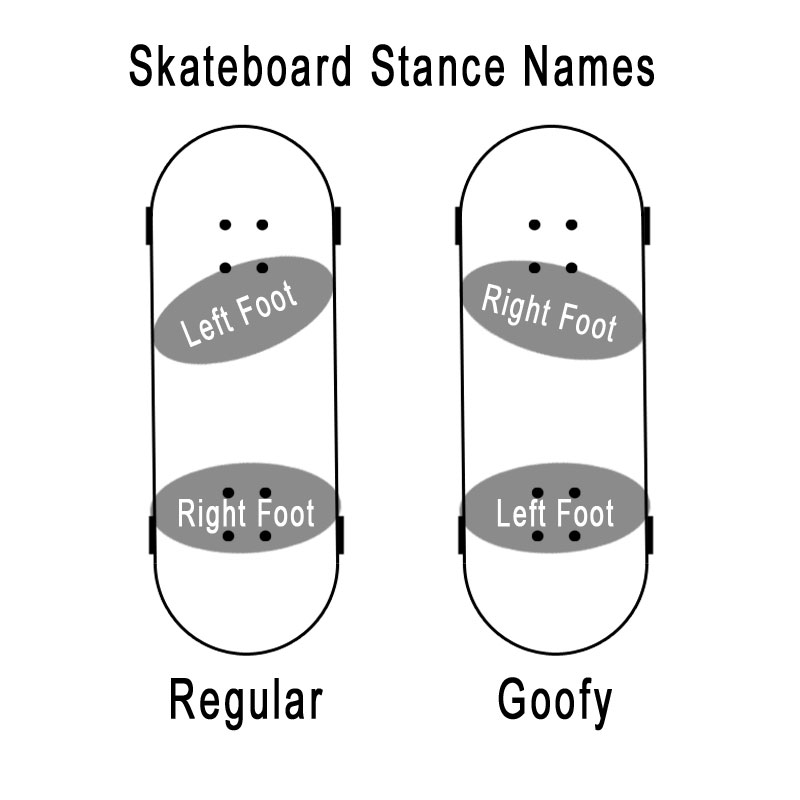
Skateboard Stances Explained
The two basic skateboard stances are Regular and Goofy Foot. Riding a skateboard “Regular Foot” means that you skate with your left foot in front and push your board with your back right foot. Riding a skateboard “Goofy Foot” means that you skate with your right foot in front and you push your board with your back left foot.
2. Practice on a Regular Basis: The more time you spend skateboarding, the more comfortable you will become with the movements.
3. Explore Different Terrains: Practice skateboarding on a variety of surfaces, including concrete, asphalt, and different types of pavement.
4. Skateboard Balance Exercises: Practice your balance with exercises like the one-legged balance, the two-legged balance, and balancing on the tip of the tail or nose of the skateboard.
One-Legged Balance: While on the skateboard, regular or goofy foot stance position, try to balance while standing on one leg.
Two-Legged Balance: While on the skateboard, stand in the middle of the board in the regular or goofy foot stance position, with both feet shoulder-width apart. Practice maintaining your balance while shifting your weight from one foot to the other.
Balance Board: A balance board is a training device that mimics the balance and movement needed for skateboarding. While the board moves, the goal is to stay balanced. In general, balance boards assist in enhancing core stability, coordination, and balance.
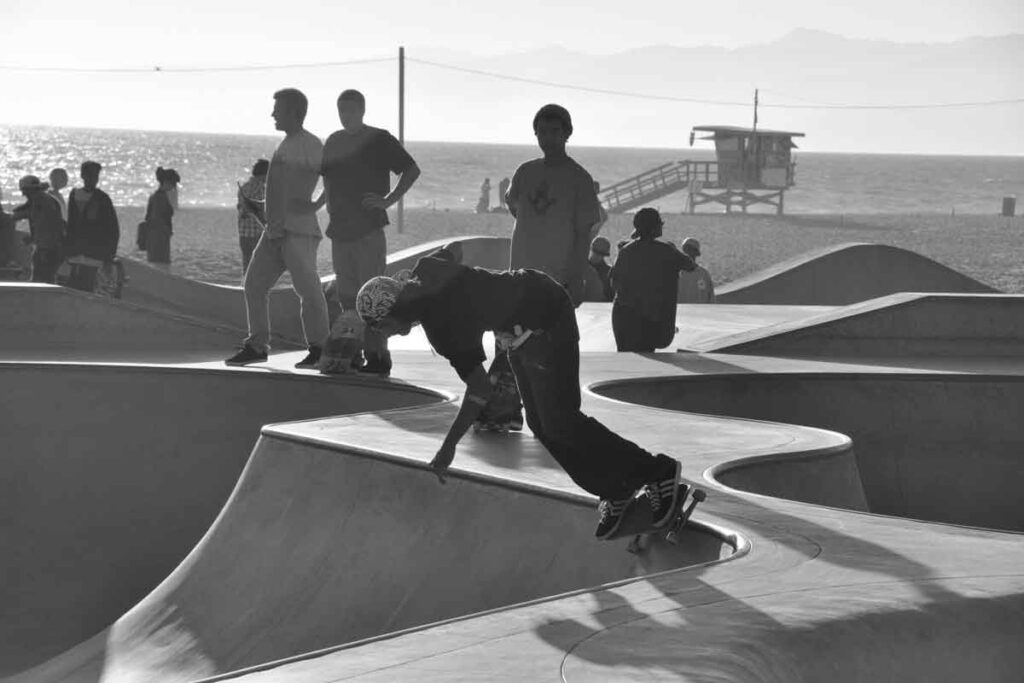
Skatepark Etiquette Tips
Skating in a skatepark can be fun and exciting, especially if you respect the other skaters and stay safe.
The following are some general etiquette, rules, and tips to consider when skating at a skatepark:
Taking Turns:
- When skating in a park, it is very important to take turns using the obstacles and features.
- Always wait your turn and don’t cut in front of other skaters.
- Also, if the park is crowded and you find yourself waiting for a long time, it might be best to move on to another spot or come back later in the day.
Avoiding Collisions:
- While at the skatepark, always be aware of the surroundings and the other skateboarders around you.
- Keep a safe distance between yourself and other skaters to avoid any collisions.
- Pay attention to people walking around, and be mindful of pedestrians and other casual park-goers.
Not Skating in Areas designated for other Sports and Activities:
- Most public parks have designated areas for different sports such as basketball, tennis, etc.
- Respect the non-skateboarding designated areas and do not skate in them.
- Skating in a non-skateboarding designated area can be both dangerous and disrespectful to those using that area for another sport or activity.
Skateboarding Etiquette at Skateparks
More Info >>
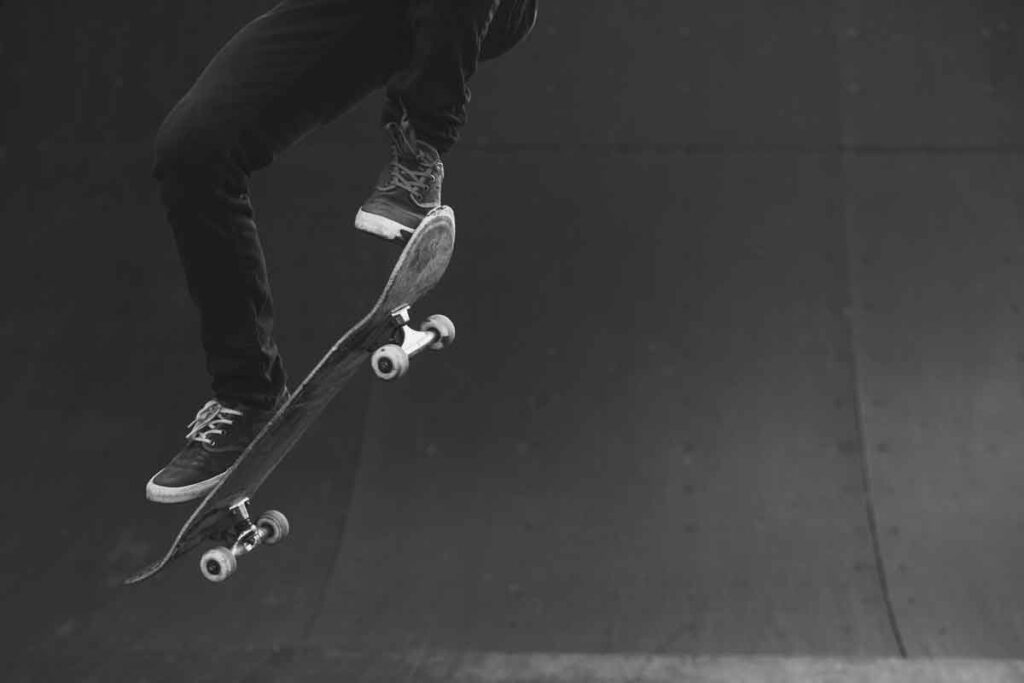
Beginner and Advanced Skateboard Tricks
Learning new Skateboard Tricks can be a challenge, especially for beginners.
Some basic tricks a beginner can practice is an Ollie, Kickflip, and Grind.
Once you have mastered the above basic skateboard tricks, you should feel comfortable enough to move onto learning more advanced tricks.
Basic Skateboard Tricks for Beginners:
The following video from Never Stop Improving on YouTube provides an easy method of learning how to Ollie on a skateboard:
To Learn How to Kickflip, watch the following short 5 minute video from CCS:
Checkout the following video from VLSkate to Learn 5 Easy Ledge Grinds:
Advanced Skateboard Tricks for Beginners:
- Nollie: A Nollie is a skateboard trick similar to an ollie but with a few key differences. A Nollie is performed by jumping off the nose of the board instead of the tail and with the rider’s front foot leading the movement.
- Switch Ollie: A Switch Ollie is a skateboard trick that is similar to a regular Ollie, but the rider performs the trick in their “switch” stance, which means that they are riding with their non-dominant foot (regular or goofy) forward.
- Fakie Ollie: A Fakie Ollie is a skateboard trick where the rider performs an Ollie while riding in the “Fakie” stance, which means that they are riding backwards or with their back foot leading.
- Heel Flip: A Heel Flip is a skateboard trick where the rider flips the board 360 degrees horizontally in the air by flipping the heel of the front foot. This trick is similar to a Kick Flip, but instead of using the back foot to flip the board, the skater uses their front foot.
- Varial Flip: A Varial Flip, also known as a “360 flip” or “Tre Flip”, is a skateboard trick where the rider flips the board 360 degrees both vertically and horizontally in the air. It’s a combination of both the Kick Flip and Heel Flip, where the skater uses their back foot to flip the board vertically and their front foot to flip it horizontally.
- Smith Grind: A Smith Grind is a skateboard trick where the rider grinds along an edge or rail of an object with the back truck while the front truck is pointing upwards.
- 50-50 Grind: A 50-50 grind is a skateboard trick where the rider grinds along an edge or rail of an object with both trucks of the board on the edge or rail. This trick gets its name from the fact that both trucks of the skateboard are on the rail or edge, hence the name “50-50”.
- Crook Grind: A Crook Grind is a skateboard trick where the rider grinds along an edge or rail of an object with the back truck while the front truck is pointing at an angle towards the rail or object. This trick is similar to a Smith Grind, but with the front truck pointing in a different direction.
- Kickflip Backside: A Kickflip Backside is a skateboard trick where the rider performs a Kickflip while turning their body 180 degrees in the opposite direction of the flip. This is different from a regular kickflip, where the rider’s body faces the same direction as the flip.
- Heelflip Backside: A Heelflip Backside is a skateboard trick where the rider performs a Heelflip while turning their body 180 degrees in the opposite direction of the flip. This is different from a regular Heelflip, where the rider’s body faces the same direction as the flip.
- Varial Heelflip: A Varial Heelflip, also known as a “Vair-Heel” or “Heel Varial” is a skateboard trick where the rider combines a Heelflip with a 360-degree horizontal rotation, resulting in a combination of the Varial and Heelflip.
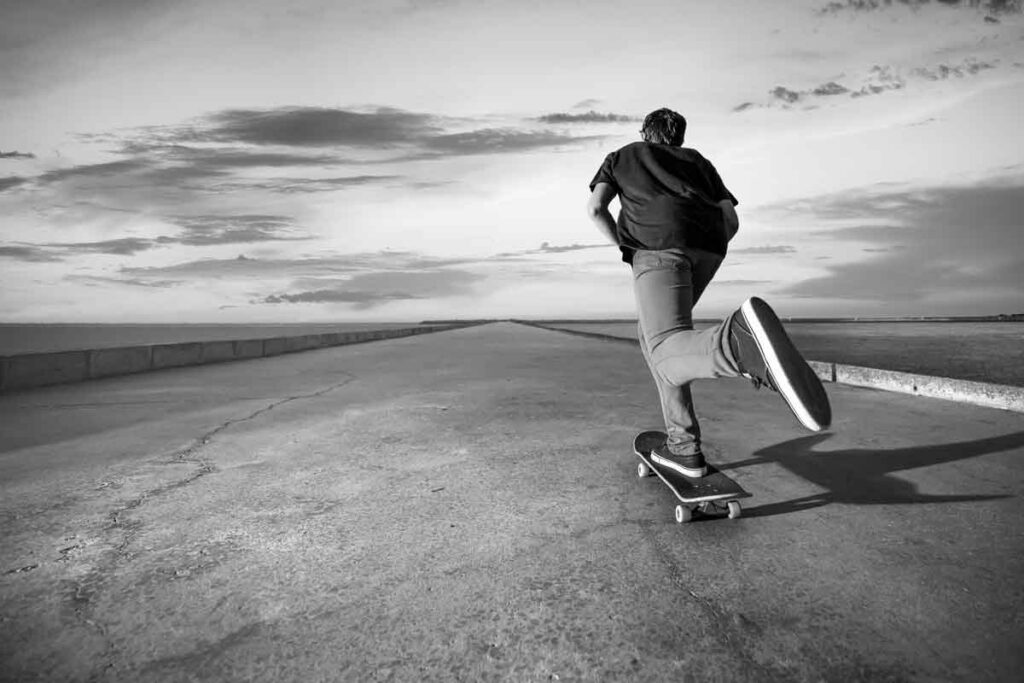
Tips for Setting Goals and Making Learning to Skateboard Enjoyable
- Start Small: Set achievable goals for yourself, such as learning how to ride the skateboard, push, turn, or do a basic trick.
- Celebrate Achievements: Celebrate every new skateboarding accomplishment no matter how small, this will help keep you motivated.
- Practice Regularly: Consistency is key, set aside time each week to practice and improve your skateboarding skills.
- Find a Supportive Community: Skateboarding is a social activity, consider joining a local skateboarding community or taking lessons so to meet other skateboarders.
- Stay Safe: Invest in quality skateboard protective gear, such as a helmet, knee pads, elbow pads, and wrist guards, to protect yourself and body while you’re learning to skate.
- Be Patient: Learning to skateboard takes time and practice, so be patient with yourself and enjoy the journey.
- Have Fun: Skateboarding should be fun, so don’t take it too seriously and enjoy the process of always learning and improving.
Skateboarding Goals
More Info >>
Conclusion
In conclusion, learning how to skateboard as a beginner is a very gratifying activity that presents countless chances for personal improvement.
With regular practice, patience, appropriate skateboard equipment, protective gear, and goal setting any beginner skateboarder can reach their goals safely and successfully.
Make learning to skateboard both motivating and fun by using the information found in this article (Beginner Skateboarding Tips) as a guideline.

